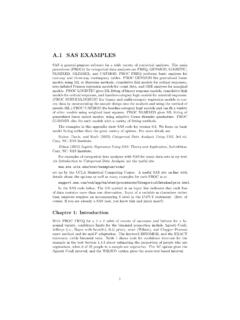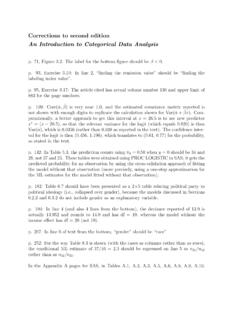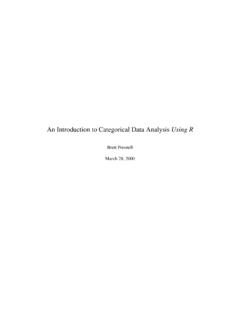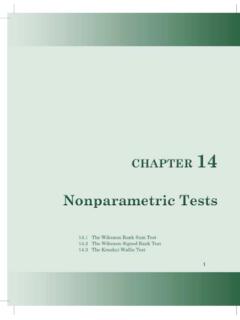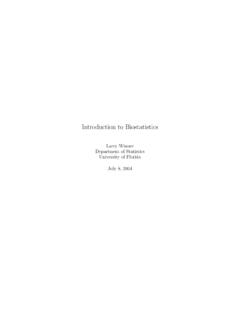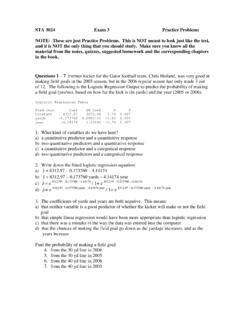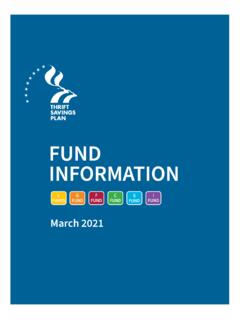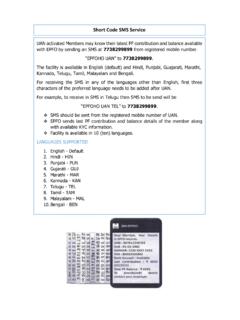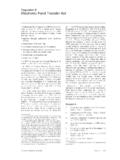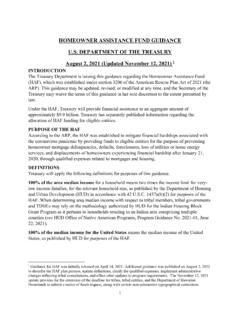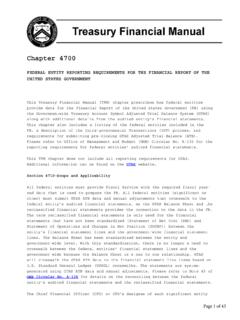Transcription of Chapter 05 - Amortization and Sinking Funds
1 Chapter 05 - Amortization and Sinking FundsSection - AmortizationAmortization Method - The borrower repays the lender by means ofinstallment payments at regularly spaced time points. The presentvalue of the installment payments equals theLoan PrincipalL=(Payment Amount) an|iExample:$1000 is borrowed with repayment by means of annual payments ofxat the end of each of 5 years. The loan has an effective annualinterest rate of 8%. What is the payment amount?- - - - - - - - - - - -5-1 TimePayment012345xPresent value:1000=xa5|.08producesx=1000a5|.08=1 000(.08)1 ( ) 5= $ the amount of each - Outstanding Loan BalanceIn the Amortization method part of each payment pays interest onthe loan and part of each payment repays some of the principal ofthe loan (the total amount borrowed).
2 At a point in the repaymentprocess we may need to ascertain the outstanding loan balance -For example,if the loan needs to be refinanced or if the loan is to be purchased byanother lender, it is vital to know how much of the original loancurrently remains outstanding loan balance can be determined in two ways:Prospectively - The outstanding loan balance is the present value oforRetrospectively - The outstanding loan balance is the originalamount of the loan accumulated to the present date minus theaccumulated value of all the loan payments that have already 1tt+ the payments are each 1 and the loan requiresnpayments. Letidenote the effective interest rate for each paymentperiod (which is also the conversion period).
3 The loan amount is the present value att=0, namely5-4We seek the outstanding loan balance , denotedBt, right after thetthpayment is :Retrospective:Bt=an|(1+i)t st|=(1 n)i(1+i)t (1+i)t 1i=1 n ti=an t|Thus either approach to this computation yields the sameoutstanding loan balance . If the loan is forLdollars, then the equalpayment amounts should beLan| , the outstanding loan balance right after thetthpayment isExample:A loan is created with 10 annual equal payments of $500 at aneffective annual rate of 6%. However, after 4 years, the borrowerneeds an additional $2000 and must restructure all outstandingdebts over the remaining 6 years at 7% effective. What is thepayment amount during those 6 years?- - - - - - - - - - - -At 4 years the outstanding loan balance is 500a6|.
4 06 The refinanced loan with payments of x dollars will have 6 paymentsand a present value at its beginning of500a6|.06+2000=xa6|. |.06+2000a6|.07= $ 5-4:A $20,000 loan is to be repaid with annual payments at the end ofeach year for 12 years. If(1+i)4=2, find the outstanding loanbalance immediately after the fourth - - - - - - - - -5-7 Section - Amortization 1tt+ the same setting as in the previous section,ntotal payments of 1repay a loan ofan|. We now examine in greater detail after the(t 1)thpayment, the outstanding loan balance isBt 1=an t+1|So the interest due at the time of thetthpayment isThe remainder of thistthpayment of 1, namelyis applied to the principal, reducing the outstanding loan balance toan t+1| n t+1=(1 n t+1)i n t+1=1 (1+i) n t+1i=1 n ti=an t|which (as we saw in the previous section) is the outstanding loanbalance right after Amortization SchedulePaymentPaymentInterestPrincipalO utstandingindexamountpaidrepaidloan balancet1iBt 11 iBt 1Bt0an|111 n nan 1|211 n 1 n 1an 2|.
5 Tth11 n t+1 n t+1an t|..n-111 2 2a1|n11 0 Totalnn an|an|5-10We see from this table that the total principal paid over allnpayments isan|, the amount of the original loan. Note also that thetotal interest paid isIn general for a loan ofLdollars an Amortization schedule isconstructed by multiplying all the entries in the four main columns(not the index) by the payment amountLan|. Banks are willing toprovide borrowers with the Amortization schedule for their loan. Itdiffers somewhat from our description due to roundoff issues,selection of a nice value for the payment amount and recursivegeneration of the entries in the :Construct an Amortization table for a loan of $1000 to be paid in 4annual payments at 10% annual effective interest - - - - - - - - - -5-11 First note that the payment amount is:L/a4|.
6 1=1000 amortiation table is thenPaymentPayment InterestPrincipalOutstandingindexamountp aidrepaidloan balance01, , , :Consider a home mortgage loan for $100,000 at 6% nominal annualrate with equal monthly payments for 30 years. What are thecharacteristics of this loan?- - - - - - - - - - - -The effective monthly interest rate isi=.06/12=. number of payments isn=12(30) = monthly payment is100000a360|.005= the end of the 30 years,Total paid on the loan is$ (360) = $215,838 withtotal principal paid$100,000 andtotal interest paid$115, amortiation table for this loan is thenPaymentPaymentInterestPrincipalOutst andingindexamountpaidrepaidloan balance0100, , , , , , , ,838115,838100,000It is apparent in this example that to borrow $100,000 the borrowermust pay $115,838.
7 The cost of the loan can be reduced by, forexample, cutting the term (time length) of the loan in half. Thisrequires much larger monthly payment alternative method uses the Amortization table, graduallyincreases the payment amounts and also cuts the loan term in this method, the borrower makes only the odd numbered loanpayments on the Amortization schedule plus the principal on thenext even numbered payment. Using the previous example, thepayments change as shown below:PaymentPaymentOutstandingindexamou ntloan balance0100, + = , + = , + = 1, , + = 1, method is only valid in settings in which the loan has noprepayment penalty. But it results in saving the borrower $57, interest charges compared to the original 30 year 5-14:A 35 year loan is to be repaid with equal installments at the end ofeach year.
8 The amount of interest paid in the 8thinstallment is $ amount of interest paid in the 22ndinstallment is $ the amount of interest paid in the - - - - - - - - -5-16 Section - Sinking fund MethodIn the Sinking fund method of repaying a loan, the borrower agreesto make periodic interest payments on the complete loan amountand to repay the loan principal at the end of the loan term. In orderto repay the principal at the end, the borrower is required to makeperiodic deposits in an interest earning account (called a sinkingfund) sufficient to accrue the original loan amount at the end of theloan (1) Supposei=effective interest on the loan per payment period=effective interest earned in the Sinking fund per pay the original loan amounti(L)is the interest due per paymentperiod.
9 Since periodic payments of 1 accumulate tosn|iover theninterest periods of the loan, then periodic payments ofLsn|iwillaccumulate toLat the end of the required periodic payment is therefore(See page 3-8.) We note that in this case,L/an|iis also the constantperiodic payment required under the Amortization method, thetwo methods of structuring the loan require the same periodicpayment : Using the setting of the first example of section , andi=.10, the Sinking fund structure produces:PaymentPayment InterestDeposit inSinking FundIndexAmountPaidSinking , , (2) Supposei=effective interest on the loan per payment periodj=effective interest earned in the Sinking fund per pay >j. If L is the original loan amount,iL=amount of interest due per payment periodand periodic deposits ofLsn|jwill accumulate these two together means that the borrower must set asidetotal payment amounts ofper period to cover both needs.
10 Note thati+1sn|j= (i j) +1an| Amortization method approach with the same total paymentamount would use an interest rate ofi that satisfies:1an|i = (i j) +1an|joran|i =an|j(i j)an|j+ :In the same setting as the previous example, consider a loan of$1000 to be paid in 4 annual payments at 10% annual effectiveinterest rate on the loan but with a growth rate of 7% annual effectiveinterest rate in the Sinking fund . The total payment required is1000[(.10 .07) +1a4|.07]= payment schedule would then be:5-20 PaymentPayment InterestDeposit inSinking FundIndexAmountPaidSinking , , this same payment $ was used in the Amortization method,it would correspond toa4|i =a4|.07(.10 .07)a4|.07+1= =. 5-20:A borrower is repaying a loan with 10 annual payments of $ of the loan is repaid by the Amortization method at 5% other half is repaid by the Sinking fund method in which thelender receives 5% effective on the investment and the Sinking fundaccumulates at 4% effective.
